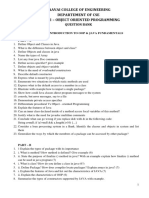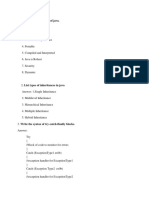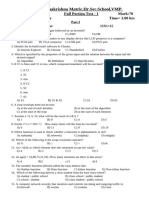0 ratings0% found this document useful (0 votes)
38 viewsJava Unit-3 Assignment Answers
Uploaded by
karanwork167Copyright
© © All Rights Reserved
We take content rights seriously. If you suspect this is your content, claim it here.
Available Formats
Download as PDF, TXT or read online on Scribd
0 ratings0% found this document useful (0 votes)
38 viewsJava Unit-3 Assignment Answers
Uploaded by
karanwork167Copyright
© © All Rights Reserved
We take content rights seriously. If you suspect this is your content, claim it here.
Available Formats
Download as PDF, TXT or read online on Scribd
You are on page 1/ 5
JAVA Unit-3 Assignment Answers
1. What is package? Explain types of package. Write steps
to create package and use the package.
Ans : A set of classes and interfaces grouped together are
known as Packages in JAVA. The name itself defines that
pack (group) of related types such as classes, sub-
packages, enumeration, annotations, and interfaces that
provide name-space management.
Types of Package :
1. Built-in Packages : The built-in packages are from the
Java API. The JAVA API is the library of pre-defined
classes available in the Java Development Environment.
Few built-in packages are below:
Java.lang–Bundles the fundamental classes
Java.io - Bundle of input and output function classes
Java.awt–Bundle of abstract window toolkit classes
Java.swing–Bundle of windows application GUI toolkit
classes
Java.net–Bundle of network infrastructure classes
Java.util–Bundle of collection framework classes
Java.applet–Bundle of creating applet classes
Java.sql -Bundle of related data processing classes
2. User-defined Packages: User-defined packages are
bundles of groups of classes or interfaces created by the
programmer for their purpose.
To Create and Use Packages :
First create a directory within name of package.
Create a java file in newly created directory.
In this java file you must specify the package name with the help of
package keyword.
Save this file with same name of public class
Now you can use this package in your program with – import
PackageName.*
2. What is wrapper class? Explain with example.
A Wrapper class in Java is a class whose object wraps or
contains primitive data types. When we create an object to a
wrapper class, it contains a field and in this field, we can store
primitive data types. In other words, we can wrap a primitive
value into a wrapper class object.
For Example :
class Main {
public static void main(String[] args) {
// create primitive types
int a = 5;
double b = 5.65;
//converts into wrapper objects
Integer aObj = Integer.valueOf(a);
Double bObj = Double.valueOf(b);
if(aObj instanceof Integer) {
System.out.println("An object of Integer is created.");
}
if(bObj instanceof Double) {
System.out.println("An object of Double is created.");
}
}
}
3. Write a difference between String class and StringBuffer
class. And explain any five method of String class and
StringBuffer class.
No. String StringBuffer
1) The String class is immutable. The StringBuffer class is mutable.
2) String is slow and consumes more StringBuffer is fast and consumes less
memory when we concatenate too memory when we concatenate t strings.
many strings because every time it
creates new instance.
3) String class overrides the equals() StringBuffer class doesn't override the
method of Object class. So you can equals() method of Object class.
compare the contents of two strings
by equals() method.
4) String class is slower while performing StringBuffer class is faster while
concatenation operation. performing concatenation operation.
5) String class uses String constant pool. StringBuffer uses Heap memory
Five Methods of String Class :
toCharArray() Converts this string to a new character array char[]
toLowerCase() Converts a string to lower case letters String
toString() Returns the value of a String object String
toUpperCase() Converts a string to upper case letters String
trim() Removes whitespace from both ends of a string
Five Methods of StringBuffer Class :
The initial capacity of a StringBuffer can be specified
when it is created, or it can be set later with the
ensureCapacity() method.
The append() method is used to add characters,
strings, or other objects to the end of the buffer.
The insert() method is used to insert characters, strings,
or other objects at a specified position in the buffer.
The delete() method is used to remove characters from
the buffer.
The reverse() method is used to reverse the order of
the characters in the buffer.
4. What is Exception? Explain Exception handling
mechanism.
An exception is an event that disrupts the normal flow of the
program. It is an object which is thrown at runtime.
The exceptions raised in your module are handled in a flow
starting with an Exception Handler element. In an action, you
can have more than one Exception Handler flow to handle
different types of exceptions.
Exception Handling Mechanism :
An exception can be raised by OutSystems or in your logic
at any point of your module. For typical UI requests, you can
handle the raised exceptions by:
Adding an Exception Handler element and its logic in your
action's flow.
Adding an On Exception action in your UI Flows.
Let the Global Exception Handler of your module do the
work. By default, Global Exception Handler property of your
module is set to the On Exception action of the "Common"
UI Flow.
In action flows starting in Timers you can only handle the
raised exceptions by adding Exception Handler elements in
your logic, otherwise, the execution flow is interrupted and
the error is logged.
When an exception is raised, the current execution flow is
interrupted and the flow restarts in the first Exception
Handler element which handles that type of exception.
5. What is user defined exception? Explain with example.
User-defined exceptions are also referred to as custom
exceptions. The exceptions created per our use case and
thrown using the throw keyword are user-defined exceptions,
and such exceptions are derived classes of the Exception
class from the java.lang package.
public class CustomException extends Exception {
public CustomException(String message) {
super(message);
}
}
public class Main {
public static void main(String[] args) {
try {
throw new CustomException("This is a custom
exception.");
} catch (CustomException e) {
System.out.println(e.getMessage());
}
}
}
You might also like
- Assignment2 Java BITsem2E Dipesh 1726290368812No ratings yetAssignment2 Java BITsem2E Dipesh 172629036881234 pages
- Java Package Mastery: 100 Knock Series - Master Java in One Hour, 2024 EditionFrom EverandJava Package Mastery: 100 Knock Series - Master Java in One Hour, 2024 EditionNo ratings yet
- Internet Programming CS8651 2 Marks & Part BNo ratings yetInternet Programming CS8651 2 Marks & Part B206 pages
- IGNOU PGDCA MCS 206 Object Oriented Programming using Java Previous Years solved PapersFrom EverandIGNOU PGDCA MCS 206 Object Oriented Programming using Java Previous Years solved PapersNo ratings yet
- Java Programming Tutorial With Screen Shots & Many Code ExampleFrom EverandJava Programming Tutorial With Screen Shots & Many Code ExampleNo ratings yet
- ICSE Class 10 Computer Applications (Java) 2013 Solved Question Paper - ICSE J0% (1)ICSE Class 10 Computer Applications (Java) 2013 Solved Question Paper - ICSE J15 pages
- Chapter 1 Abstract Data Type and Introduction To STL (Part 1)No ratings yetChapter 1 Abstract Data Type and Introduction To STL (Part 1)17 pages
- Cheng Yang, Zhiyuan Liu Et Al - Network Embedding Theories, Methods, and ApplicationsNo ratings yetCheng Yang, Zhiyuan Liu Et Al - Network Embedding Theories, Methods, and Applications244 pages
- Finaljava - Copy - Book (1) - Pages-8-111No ratings yetFinaljava - Copy - Book (1) - Pages-8-111104 pages
- A Quick Start Guide For The MARIE Machine Simulator EnvironmentNo ratings yetA Quick Start Guide For The MARIE Machine Simulator Environment3 pages
- Curriculum Structure of 2 Year MCA ProgrammeNo ratings yetCurriculum Structure of 2 Year MCA Programme5 pages
- Course Syllabus - Spring Semester 2022/2023 DS 14350 Computer Architecture For Machine LearningNo ratings yetCourse Syllabus - Spring Semester 2022/2023 DS 14350 Computer Architecture For Machine Learning3 pages
- B.Tech III Year I Semester (R15) Regular Examinations November/December 2017No ratings yetB.Tech III Year I Semester (R15) Regular Examinations November/December 20174 pages
- MS Excel Training Smaple Data For PracticeNo ratings yetMS Excel Training Smaple Data For Practice90 pages
- Courtesy:: National Informatics Centre, Gujarat Https://ojas - Gujarat.gov - in Page 1 of 2No ratings yetCourtesy:: National Informatics Centre, Gujarat Https://ojas - Gujarat.gov - in Page 1 of 22 pages
- Opendss Loadshape Usage (Version 7.3.3) May 15, 2010: New Ways To Enter Array DataNo ratings yetOpendss Loadshape Usage (Version 7.3.3) May 15, 2010: New Ways To Enter Array Data5 pages
- United International University: Lab Sheet 1 Introduction To CNo ratings yetUnited International University: Lab Sheet 1 Introduction To C9 pages
- It 1352-Cryptography and Network Security Question PaperNo ratings yetIt 1352-Cryptography and Network Security Question Paper2 pages
- Analysis and Design of Algorithm Practical FileNo ratings yetAnalysis and Design of Algorithm Practical File21 pages

































































































